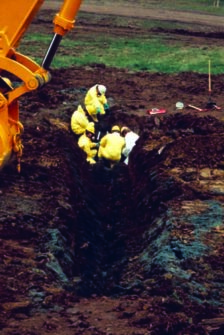Preventing trench collapses

Workers caught in trench collapses rarely survive because soil can be extremely heavy. A cubic yard of soil can weigh up to 3,000 pounds – roughly the weight of a small motor vehicle, according to OSHA.
In 2016, 23 workers died and 12 others were injured in trench collapses, the agency notes. However, trench deaths and injuries are preventable.
Not worth the risk
Entering an unprotected or insufficiently protected trench means putting your life at risk, NIOSH warns, as trenches give no warning that they’re going to collapse.
Why do trench collapses occur? NIOSH cites numerous potential factors, including soil type and water content, environmental conditions, proximity to previously backfilled excavations, weight of heavy equipment or tools, and vibrations from machines and motor vehicles that can affect soil stability.
Before trench work
An abundance of safety preparation should go into planning a trenching job, NIOSH states. Employers should call 811 before digging to have utility lines marked. A competent person should be on hand to ensure all safety measures are in place and followed, and he or she should evaluate the soil to ensure it’s stable enough for a trench. (Go to osha.gov/SLTC/competentperson for more information on what constitutes a “competent person.”)
The competent person also should determine the specific type of protective system that will be needed. The job plan should be laid out in a way to identify safe spots away from the trench for spoil piles and heavy machinery routes.
During trench work
Once planning is complete and the work on the trenched jobsite begins, safety must remain the No. 1 priority. NIOSH states that the competent person must continue to inspect the excavation site, all adjacent areas and protective systems every day before work begins, throughout the shift and after every rainstorm. Vehicles must be kept at a safe distance from the excavation, and ladders and other means of exit from the trench must be no more than 25 feet away from workers at all times.
Learn more about preventing trench collapses at sh-m.ag/2AJcAdl.
Post a comment to this article
Safety+Health welcomes comments that promote respectful dialogue. Please stay on topic. Comments that contain personal attacks, profanity or abusive language – or those aggressively promoting products or services – will be removed. We reserve the right to determine which comments violate our comment policy. (Anonymous comments are welcome; merely skip the “name” field in the comment box. An email address is required but will not be included with your comment.)

